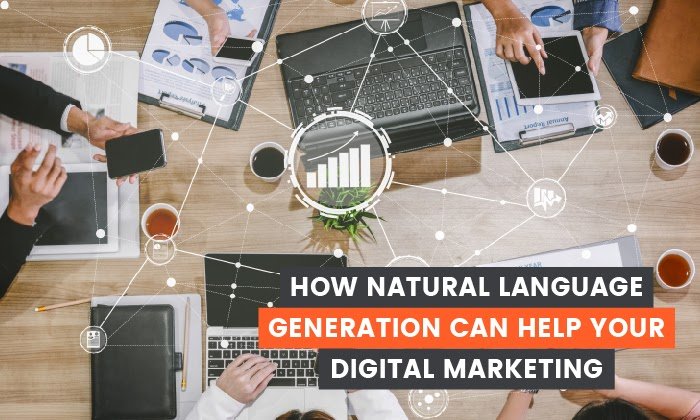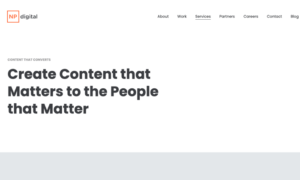You might be familiar with A.I. and what it can do. You might not know that there is a subset of it that plays a vital part in digital marketing. It’s called Natural Language Generation, and it’s more prevalent than you might think.
One of the best examples of natural language generation is Google’s Smart Compose. If you use Google’s email platform, you’ve already seen this in action: as you type out an email, Google provides suggestions to finish your sentence.
That’s natural language generation at work.
Natural language generation has some incredible implications for your digital marketing campaigns.
Before we go in-depth about natural language generation and how it can help your promotions, let’s take a minute to explain what precisely natural language generation is and what it does.
What Is Natural Language Generation (NLG)?
The definition of natural language generation is the “process of producing meaningful phrases and sentences in the form of natural language.”
Natural language generation comes from your structured data. It transforms the data you have into natural-sounding text. It can also produce a vast volume of written words far quicker than the average person.
However, its capabilities don’t stop there. Natural language generation allows the updating of existing text and automation. You can also use it to create:
- Images
- Graphs
- Numerical data
You can see why natural language generation is attractive to marketers. However, natural language generation is beneficial for a range of other sectors, including:
- Finance and data analysis: For report creation
- Healthcare: For interpreting data and creating medical reports
- E-commerce and retail: Produce accurate product descriptions and improve the overall customer experience
- Journalism: Create and update news reports. The Associated Press and Bloomberg are just two organizations using data to expand their news coverage.
- Logistics and travel: Keep passengers updated, write itineraries, and translate texts into various languages.
- Customer service: Enables chatbots to answer questions and follow up with personalized emails for a more ‘human’ approach.
- The insurance, energy, and telecommunications industries: These sectors have successfully introduced natural language generation to optimize their customer service, send out bills and invoices, and for report creation.
If the forecasts are correct, natural language generation will be used even more in the future.
Natural Language Generation and the Wider AI Picture
Now you know what natural language generation is and a bit about what it does. Let’s take a moment to explain how it fits into the overall AI picture.
If you’ve read about natural language generation before, you’re probably aware of similar terms like natural language processing and natural language understanding. These terms are often used in the same conversation, as they all fall under the AI umbrella.
There might be a bit of confusion on how these terms differ, so we’ve highlighted key differences below.
Natural Language Processing (NLP): While natural language generation’s purpose is to use your data to produce text, it’s NLP’s role to process and read the language.
NLP can also help with
- Spelling corrections and grammar
- Machine translation
- Syntax and context
Natural Language Understanding: Another term you’re likely to come across is Natural Language Understanding (NLU). NLU analyzes text to understand intent and meaning. NLU enables:
- Text summarization
- Spelling correction
- Sarcasm detection
Then there’s machine learning.
You’ll find a wide range of definitions out there, so let’s go with the one from the MIT Technology Review:
Machine Learning algorithms use statistics to find patterns in massive amounts of data.
Machine learning can process far more than just text. ML can also process images, figures, and clicks. Without it, we wouldn’t have the likes of Siri or YouTube.
Now we’ve covered these key terms, let’s delve into natural language generation and its possibilities for your digital marketing campaigns.
How Does Natural Language Generation Affect Digital Marketing?
Natural language generation has been with us since the 1960s, so it’s not new. However, what has changed is its commercialization and wide availability. You may have noticed there are numerous types of natural language generation software available now.
Plus, natural language generation’s capabilities have transformed recently, meaning improved accuracy. Its potential for the future of digital marketing is enormous.
From the first time a customer interacts with you to the follow-up and personalization of your marketing efforts, natural language generation can play a role in every stage.
Suppose you regularly employ a team to identify keywords, perform SEO, create product descriptions, and analyze marketing data. With natural language generation, you can automate all these tasks. Here are a few other ways natural language generation can help in your marketing.
Create Content
As a marketer, you know the importance of communicating regularly with your customers and would-be buyers. It can help build consumer trust, enhance customer loyalty, and allow you to demonstrate your expertise. It also goes a long way toward growing your brand.
Regularly producing fresh content that speaks to your customers is time-consuming and often costly. Natural language generation can solve this issue by allowing you to create keyword-optimized:
- Blog posts
- Web and landing pages
- Newsletter and email content
- Reports
- General marketing content
However, it also helps create targeted content and enables teams to make sense of their data. Marketers can then use the information they have to create compelling, tailored campaigns for improved success.
But the real beauty of natural language generation? All it takes is three simple steps:
- Get your data ready
- Prepare/use a template
- Let natural language generation choose your narratives and write your content
The Associated Press is an excellent example of how to use natural language generation well. AP uses natural language generation to produce financial reports and expand sports coverage, among other things. Additionally, the Washington Post uses natural language generation to generate hundreds of press releases.
Generate Product Descriptions
If you’re an e-commerce business owner, you understand the importance of well-crafted product descriptions to drive traffic to your site. However, it can be challenging to produce vast quantities of unique, SEO-orientated content that matches your company’s tone and voice.
While you could just go with the original, manufacturer-supplied descriptions, they’ll lack originality, which isn’t great for SEO.
Imagine if you had a way to take your unstructured data and insert it into a template and have the writing done for you?
That’s what natural language generation can do. It can transform your data into hundreds or even thousands of original descriptions that match your brand’s voice.
With natural language generation, you can create thousands of automated descriptions detailing:
- Weight
- Size
- Key features
- Colors
To get a better idea of what this looks like in practice, let’s use a free natural language generator tool.
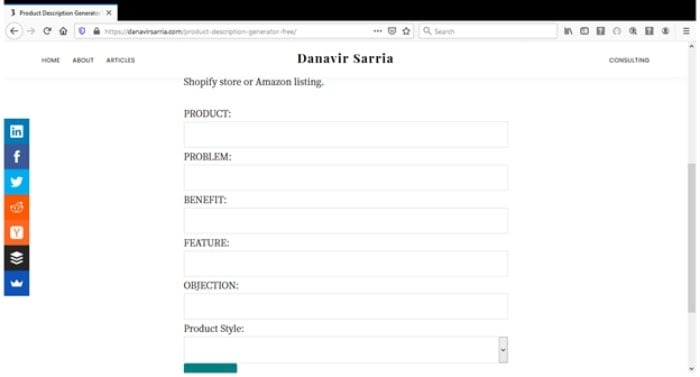
You just enter your:
- Product name
- The problem it solves
- Benefits and features
- Objections
- Product style
Then click “generate” and wait for your description to appear.
Write Ads
With its ability to personalize and tailor content, natural language generation has a lot of potential for writing ads. However, it’s not just about putting words on the page. Natural language generation aids ad creation by helping you understand your audience and their intent.
Natural language generation is even intelligent enough to adapt to a brand’s audience and use the language and tone most likely to resonate with them — all without compromising your ads’ creativity.
A further benefit of using natural language generation to create ads is it allows mass scaling while also sounding human and personalized. That all makes natural language generation ideal for:
- Online paid ad (Google, Facebook, Amazon, etc.)
- Landing pages
- Individual customer offers
These are just examples. However, they should illustrate the possibilities for your digital marketing efforts.
Personalization
Personalization isn’t a buzzword or a passing trend: It’s one of the most critical elements of a successful marketing campaign.
When you apply natural language generation to your marketing efforts, there are several ways you can use it to tailor it to your customers, including:
- Use natural language generation to understand individual customer’s metadata for the personalization of marketing materials.
- Improve customer loyalty by targeting products, services, and special offers to your buyers.
- Automatically updating and tailoring content for individual customers
- Reach a broader customer base through localization
From these examples, it’s easy to see why brands turn to natural language generation to apply personalization to their campaigns.
Automated Updates
Relevant content is essential to online sales, and it’s vital for seasonal promotions. For example, when you want to promote your Black Friday sales or if someone is searching for Valentine’s gift.
However, keeping your content up-to-date is a challenge.
Updating seasonal content is another area where natural language generation shines. For example, you could automate category pages aimed at specific buyers by letting natural language generation create individualized content, making it targeted and more likely to convert.
By automating and updating content through natural language generation, you enhance the overall customer experience, increasing the likelihood of a sale.
Subject Line Generation
A good subject line is one of the essential parts of your email. After all, it can mean the difference between your message getting opened or not. Natural language generation can take your data and optimize subject lines to ‘speak’ to the receiver.
Natural language generation can convey and personalize sentiments, tone, and language, helping improve your email open rates. One example of this is the AI technology company Phrase.
The UK-based business’s natural language generation tool allows you to generate hundreds of effective subject lines. For instance, when Virgin Holidays wanted to improve customer experience and grow digital sales, it introduced Phrase to tweak its subject lines.
The result? A two percent increase in open rate, which may not seem like a huge increase, but it was worth millions to Virgin Holidays.
If you want to leverage the potential of natural language generation for your email campaigns, there are a few tools you can try:
First, Active Campaign has a free tool. Just choose a keyword category from the drop-down list, enter your keyword, and click the “generate subject lines” button.
We used “headaches” as our keyword, and these are the suggested subject lines:
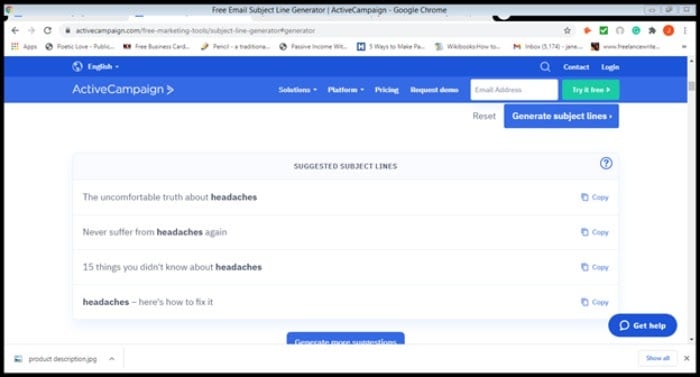
Automizy is another free tool. It uses three steps to generator subject lines.
- You copy and paste your email marketing content
- Automizy will take your text and analyze it
- Then, it generates a set of subject lines based on your copy.
From experience, we can say the above tools might not be perfect. However, they do illustrate the potential and give you a starting place.
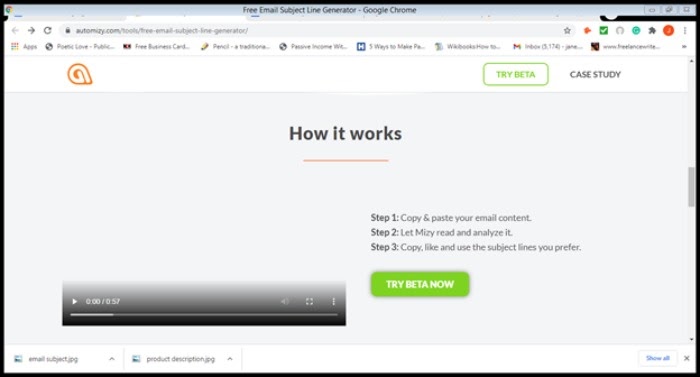
SEO Optimization
According to Marketing Artificial Intelligence Institute, there are several ways marketers are using A.I. in SEO optimization. They’ve introduced it to:
- Discover keywords and create topic clusters
- Optimize content for better discoverability
- Content analysis to find content caps
- Create real-time targeted content
- Write meta descriptions
- Tag images
- Write outlines and titles for your content calendar
Using natural language generation can help marketers drive more traffic, create more sales, and build their brands.
Conclusion
Natural language generation software has applications across a broad range of industries. Natural language generation allows users to create personalized, automated text. Still, its real power lies in adapting to individual brand voices, making it an ideal way for digital marketers to build relationships with a specific audience.
Digital marketers can also generate cost-effective, timely campaigns, optimize their ROI, and interact more authentically.
Despite some people’s fears, natural language generation is not going to steal anyone’s jobs. Rather, natural language generation complements copywriters’ work while freeing up vital time to concentrate on ROI-generating goals.
How could natural language generation help your business? Share your thoughts below.
The post How Natural Language Generation Can Help Your Digital Marketing appeared first on Neil Patel.

